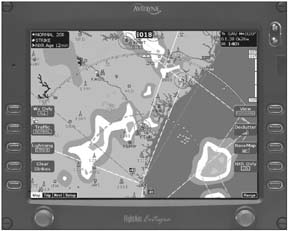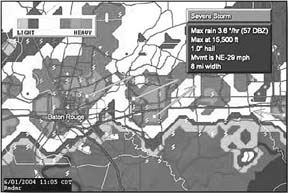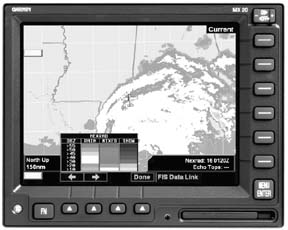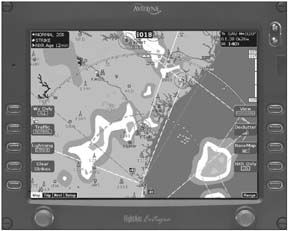
by Larry Anglisano and Paul Bertorelli
Like everyone else contemplating installing weather datalink in the cockpit two years ago, we were awaiting the inevitable shakeout as numerous contenders vied for what appeared to be a limited market. Although the market has grown, it appears to us that XM Radio-based WxWorx datalink is emerging as the one to beat, with WSIs satellite-based system as strong competition mainly in the panel-mount realm.
WxWorx has achieved its market dominance, to a degree, by defying tradition. In the past, developers have typically forged relationships with a single box or display maker-such as EchoFlight with Garmin and Bendix/Kings ground-based design with exclusive use of the FAAs FIS weather data system.But WxWorx has made itself available to all takers, first with inexpensive, easy-to-install portable systems and now, just coming online, certified systems for Garmin and Avidyne panel mounts.
As a result, there are a handful of ways to get XM-based weather into the cockpit at prices ranging from under $1000 to $8000 certified panel-mount systems. In this article, we’ll examine most of the attractive options. But this field is evolving fast, so prices and equipment are subject to change.
Basic XM
XM-based weather is delivered through a pair of geostationary satellites-soon to be three-primarily devoted to XM Radios entertainment channels but with set asides for the growing datalink market. The two satellites provide coverage only in the contiguous U.S. The weather data itself-marine, aviation and terrestrial-comes from WxWorx, an independent company formed by Bob Baron, who previously founded Baron Services to deliver NEXRAD imagery to the television broadcast market.
As it does for entertainment, XM requires a dedicated radio receiver but one specifically designed to function with a small, internal puck-type antenna. Currently, WxWorx markets a portable receiver that outputs to laptops, tablets and personal digital assistants (PDAs) and, just coming to market this year, a range of certified panel mount receivers.
The weather service is billed monthly by XM at a flat rate and comprises two service levels. (See the sidebar for details on what each service level provides.) The portable systems operate from an XM receiver built by WxWorx thats about the size of a CD player and 1-inch high. It uses a glareshield antenna, ships power and has a data output cable to connect to a computer or PDA.
The hot new option is Bluetooth wireless capability to eliminate the rats nest of wiring that makes portable XM such a nuisance in the cockpit. As of mid-March, WxWorx is selling a battery-powered Bluetooth GPS that works wirelessly with a laptop or tablet and by April or shortly thereafter, it was planning to introduce wireless capability between the XM receiver and the computer. As we reported in the April 2005 issue, the Bluetooth option is becoming increasingly practical, for it reduces the wiring nuisance down to power cables for the PDA or computer and the XM receiver and the antenna wire.
What follows is a market scan of portable panel-mount options. Portables are generally package deals but are also sold la carte, thus if you already have a laptop or PDA, you can buy just the XM hardware.
Control Vision
With its Anywhere Map products, Control Vision is a major player in the GPS PDA market and has added the XM weather package to its offerings. It currently sells three PDA-based packages. Top of the line is the so-called Dual Bluetooth that includes an iPAQ 4705 PDA, the XM receiver and a Bluetooth wireless transmitter that makes the entire system wireless in the cockpit. It sells for $2395, including a wireless GPS receiver. For $100 less, you can buy the same system with a hardwired GPS receiver.
Control Vision also sells upgrade packages for existing PDAs and for laptops. If you already have a suitable laptop, Control Vision has a $1595 package that includes the XM receiver, the Anywhere Map software (for Windows XP) and a Bluetooth wireless GPS which provides nav and position data to show proximity to weather. However, the computer is still hardwired to the receiver.
Last summer, Control Vision announced a new display option called the Raven, a small, affordable PC tablet computer. As of press time, Control Vision was just beginning to ship this hardware at a price of $3495 in an XM bundle. Its not currently Bluetooth-capable, but has a combined data/power cable set-up to obviate the need for wireless.

NavAir
Like Control Vision, NavAir offers a range of PDA-based XM weather options.You can buy just the XM hardware/software package and provide your own PDA, tablet or laptop or you can buy a turnkey set-up with all the hardware ready to go.
If you already own a pocket-PC type PDA, a NavAir bundle with the XM receiver, GPS, the software and the cabling sells for $1695. A double Bluetooth version-no wires between the GPS, the XM receiver and the display device, sells for $1785. NavAirs full bundled packages, including the PDA, sell for between $2495 and $2895, depending on the type of PDA and how much memory it has. NavAirs version of the lower cost, tablet approach are the Sony U50 and U750 palmtop PC computers running a software packed called NavAirEFB. As with Control Visions Raven, the Sony PCs will run map software, approach plate software, flight planning, checklists and anything else youd use an EFB for. But they arent cheap. The Sony U750 with the XM double Bluetooth bundle sells for $4250.
True Flight
Another company plying the portable XM market is True Flight, which, like the others, sells both the display technology and the XM hardware. Although True Flights bundles arent as we’ll organized or as easy to understand as those from Control Vision, it offers different products. At the bottom of the line, for instance, is a $995 display-only device called a Flight Cheetah 180; you provide your own laptop and place it elsewhere in the airplane, with the Flight Cheetah on the yoke. True Flight sells the XM receiver separately ($595) and provides the cabling and software. Some assembly required.
True Flight sells three other versions of the Flight Cheetah ranging in price from $2995 to $4990, plus the cost of the XM hardware. True Flight also sells the T Pad 800, a customized cockpit computer with a remote CPU and color tablet display.
Obviously, being full-up PC platforms, these devices will run more software than palmtop PDAs, including non-aviation applications, if thats of interest. True Flight also offers attitude display hardware and something no one else has: high resolution LandSat imagery that can be overlaid on the moving map.
Another low-profile provider of portable XM weather is MountainScope from PCAvionics, which provides XM capability for its Pocket PC-based mapping software. However, the companys Web site says the Pocket PC version has a modification that hasnt yet been tested. we’ll take another look at this product as it matures.
Panel Options
With Garmin GDL49/Echo Flight data system, Garmin was early to the market but the system has proven to be a disappointment, with slow link speeds and dated NEXRAD returns. Some GDL49 installations definitely do perform better than others, which may also be the case with XM. But geostat satellite-based XM and WSI technology has proven far more reliable and resistant to interference and noise.
As we go to press, bits and pieces of the made-by-Garmin GDL69 XM system is shipping to dealers with the promise of the dual data and entertainment-capable GDL69A for the last quarter of 2005. The GDL69A will require new Garmin software which adds WAAS capability to the GNS400 and 500 series navigators. In other words, no WAAS upgrade, no audio capability on the XM side.
Controls for tuning the entertainment stations will be contained within the navigators software and or externally controlled through optional control heads mounted in the cabin. As slick as this might seem, we find that many owners have a blas attitude toward XM Radio and are more interested in the plain-Jane, no-tunes GDL69, aimed strictly at reliable weather retrieval.
While an untrained eye might find the GDL49 and GDL69 hardware similar, theyre quite different. Owners of current GDL49s shouldnt expect a direct slide-in replacement with the GDL69 receiver. First, the antenna will need to be replaced, which is a good thing. Gone is the awkward VHF whip antenna that handles the handshake to Orbcomm and on goes the GA55 GPS-style antenna, with less drag and more flexible mounting options. The 2.83-pound GDL69 remote unit, including mounting rack, measures 6.15 by 1.05 by 7.20 inches, making it ideal for mounting in the avionics bay or underneath the cabin.
The GDL69 talks to the GNS500 and GNS400 series navigators, as we’ll as the MX20 MFD, using RS232 input. There’s also a remote configuration module that stores pertinent installation details, eliminating reconfiguration whenever a different unit is swapped. In many cases, some existing interface wiring from a GDL49 can be retained. Of course, with a GDL69A, additional wiring will be required to provide the entertainment audio input to the intercom system.
While the GDL69 has PMA approval, it doesnt have a multiple STC, so shops must solicit certification via FAA field approvals, which accounts for a sizeable part of installation costs. List price for the GDL69 hardware is $4995, which includes the GA55 external antenna. The GDL69A will retail for $6775.
Heads Up/Avidyne
Avidyne encountered the same problems Garmin did with iffy performance of its own Orbcomm-based datalink but now owners of EX500 and big-screen EX5000s have an XM-based alternative. Interestingly, the Orbcomm receiver is still an active feature of the EX500-a potentially worthy supplement to the XM option-and offers two-way messaging and flight tracking, which XM doesnt have.Avidyne calls this combination Multi-Link.
The XM hardware is made for Avidyne by Heads Up Technologies, a proven player in several arenas and as we go to press, its on the verge of releasing the long-anticipated XMD-076 receiver and accompanying external antenna.
As with Garmin, there’s future promise of streaming the 101-channel XM Radio service through its single antenna with entertainment tuning through a remote control head. There’s already such an interface playing in corporate aircraft and it can provide individual controls to all seats in the aircraft. Heads Up tells us that the cost of this interface doesnt make it a candidate for small airplanes, although it might be a good idea for the future.
The XMD-076 receiver weighs 2.5 pounds and measures 6.45 by 1.82 by 7.80 inches. Installation is similar to bolting down a GDL69. The same is true for the antenna and, in either case, if you own a pressurized airplane, DER engineering approval for the antenna work is needed and will be charged accordingly.
To play on the Avidyne EX500, the MFDs software must be version 2.0, which also allows interface of onscreen approach charts. The Heads Up XMD-076 and antenna cost $3750 and the software upgrade for existing EX500s is another $500 and is field installable. New EX500s will come standard with software version 2.0, but as we go to press, this software has not been released. Interestingly, XM Datalink weather is already playing on EX5000C displays available in Cirrus airplanes. On a recent test flight, we found that this system worked terrifically.
Conclusion
As noted, WSI is a worthy competitor to XM-based services and the company deserves credit for pioneering this field. we’ll look at that product in a future report. Meanwhile, WSI will have to cope with a veritable onslaught of XM-based options, both portable and panel.

Which should you choose? On the portable front, if you already have a laptop or tablet, you cant do much better than buying the necessary XM stuff directly from WxWorx. You can get into the program for about $1000, or about $1300 if you want to fool around with Bluetooth to avoid the wiring hassle. For turnkey systems, see the chart on page 10 for listed options. Were most impressed with offerings from Control Vision and NavAir.
One caveat about portables: The FAA doesnt like them much and leaves it up the designated Repair Station network to judge whether a portable set-up is safe enough to be airworthy. If there’s any hint that the so-called portable interface borders on being a permanent mount, the shop takes the liability and will lobby for field approval. As clever as some owners think they may be by building custom mounts and interfacing with ships power, many portable set-ups are unairworthy in the eyes of the FAA. Some are even hazardous. Think of what a Dell laptop would do to your noggin if it broke loose in turbulence or in a crash. If you opt for a portable with a laptop/tablet, use commonsense in wiring and mounting it.
Your choice in panel-mount hardware will be determined by the display youd like to use. We think the Garmin GNS 430 is on the small side, displaywise, but the 530 is adequate. The MX20 is better yet and the GDL69 will drive all three. If you already have the Avidyne EX500 or tilt toward it as a MFD, the Heads Up XM receiver is the only choice. At present, the EX500 is the only display that can play both airborne and datalink radar in a small aircraft, therefore, the EX500 may be the only choice if youre upgrading an older radar indicator.
Also With This Article
“Checklist”
“XM Panel Mount/Portable Options”
“XM Weather Data: Which Version?”





